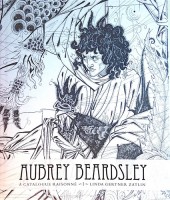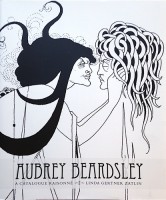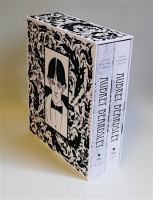The browser will either open the file, download it, or display a dialog.
Linda Gertner Zatlin,
Aubrey Beardsley: A Catalogue Raisonné.
New Haven and London: Yale University Press for
the Paul Mellon Centre for Studies in British Art, 2016.
2 vols.; 1112 pp.; 75 color illus., 1145 b&w illus.
$300.00
ISBN: 978-0-300-11127-9 (cloth)
Linda Zatlin’s monumental work on Aubrey Beardsley has finally been published by Yale University Press after many years of anxious anticipation. The product of a lifetime of intensive study, field work, appreciation of hidden works of art, and digging in libraries and archives, this volume is destined to become the primary book for any study of Beardsley’s work in the future. Since Beardsley’s reputation as an artist is held in high esteem by anyone studying the fin-de-siècle, this book has been long awaited. What makes the book (appearing in two volumes) so substantial is the loving care that Zatlin has expended in trying to find out about Beardsley’s imagery against the backdrop of the period in which he worked. Since he was only twenty-five when he died in France in 1898, the task before Zatlin would have appeared easy, especially since he had only six and a half years of professional activity; but in locating and interpreting his life time of work, Zatlin was confronted with an overwhelming productivity, the result of a fecund mind that never stopped thinking about what to create next. What this beautifully produced book reveals is numerous works of staggering beauty and originality.
Organized lucidly, the book is prefaced by a careful chronology that situates Beardsley within his time frame so that a reader easily can grasp when he worked. Then the catalogue examines the various periods of his development through carefully orchestrated sections: Juvenilia (1880–1888); Early Drawings, Japonesques and Grotesques (1889–1893); Major illustrations for Salome and The Yellow Book (clearly his best known images); and his other drawings and posters (1894–1896). Each section is preceded by a carefully presented study of what the various works mean so that an understanding of Beardsley’s range of productivity is established. Each work is reproduced with the best possible illustration, further encouraging the reader to study the images themselves in depth. The works are also carefully interpreted and contextualized with painstaking evaluations of each one, allowing the reader a rare opportunity to learn how Beardsley’s fame as an illustrator and designer was established, as well as the nature of the controversies he ignited. The method that Zatlin has established not only reinforces Beardsley’s range of creativity but also demonstrates the detective work that she has conducted to locate each work and interpret the pieces with care and perspicacity.
At the end of the book Zatlin includes sections on Beardsley’s drawings in letters, in books he owned, and drawings that are known but could not be located. The book also has a section on forgeries and parodies, further extending the range of what Zatlin has contributed. A listing of the dramatis personae is also exceedingly helpful as few—save for a handful of experts—will know the names of the individuals that are cited throughout the volumes. This is a most helpful detail.
A professor of English, Zatlin shatters the myth that only an art historian could have developed such extensive scholarship on a single artist. Since Zatlin was exceptionally sensitive to words, texts, and the relationships between these areas, she brought a keen intelligence to the project. She was not blocked by extensive art historical verbiage, or by the need to obfuscate. Instead, her text throughout, whether chronicling Beardsley’s short life or interpreting his images, remains clear, concise, and rooted around the images being discussed rather than citing some arcane theory. This makes her book accessible to all—not just scholars of Victorian literature, but anyone who would want to discover more about an artist whose international reputation spans generations, countries, and time periods.
What Zatlin does more than anything else is to demonstrate through words and images just how Beardsley raised the status of “the profession of drawing for books” (xiv). Sympathetically locating all of Beardsley’s works revealed that this artist, more than anyone else since William Blake, valued the importance of book illustration (along with magazine illustration). In keeping with the spirit of the Symbolist and Art Nouveau period, Beardsley was determined to show that all the arts were equal. Zatlin supports this philosophy in her text by setting an example of how this approach might be implemented today. Throughout her book Zatlin does not shortchange the key influences on Beardsley’s development. Whether it was the influences from the streets of London, or his excitement in seeing and studying Japanese prints (especially the sexual shunga prints), Beardsley’s wondrous images are studied at length, especially his series of drawings for Oscar Wilde’s 1891 play, Salome. Zatlin deals straightforwardly with the controversy surrounding some of these images, expounding on the ways in which people (and some critics) found his work stimulating in the use of line while simultaneously deploring some of his content.
Throughout the book one is impressed by the extensive detail that Zatlin brings to her interpretations of text and image. This is especially notable in the ways she examines the original drawings for the Salome series (1893), examples of which are found in the Fogg Art Museum at Harvard. Here Zatlin not only carefully studied each work, but also located where the work was exhibited, how it was handled in previous literature, and where it was originally reproduced. In the case of The Dancer’s Reward (no. 873 in Zatlin), the author also examines what she believes to be the inspirations for the drawing, including Henry Fuseli’s Salome Receiving the Head of John the Baptist for Francis Willoughby’s Practical Family Bible. In addition, Zatlin suggests that inspiration for the decapitated head came from other sources such as Botticelli’s Pallas and the Centaur. This grasp of art works from previous periods of time is not only helpful for the work under question, but also demonstrates how astute Beardsley was in using examples from many eras for his own work. Zatlin goes further into the genesis of the drawings by examining the designs that were considered, but never used. In the case of the book cover for Salome, she reproduces the original proposed Peacock Feather design for the book that was rejected by Oscar Wilde; it is valuable to see this preliminary drawing especially when the next number in the catalogue is the actual cover that was employed (nos. 879 and 880).
The next section in the catalogue raisonné is prefaced by an excellent, albeit short, essay on the proliferation of art and literary magazines during the 1890s. None is more iconic or more controversial than the famous illustrated quarterly publication, The Yellow Book, especially since the magazine was both satirical and deeply sexual. These aspects are concisely discussed by Zatlin in an essay that should become basic reading not only for those interested in Beardsley, but also for anyone who wants to understand what was actually happening in art and literary circles dedicated to the role of the avant-garde. Zatlin also chronicles the way in which The Yellow Book was greeted by critics. Some praised its originality, some railed against its insolence, while others were repelled by Beardsley’s control of the visual style. Without detailed information on why Beardsley was fired (‘sacked’ is the word Zatlin uses, vol. 2: 66), the fame of The Yellow Book, and its incontrovertible achievements, are due to Beardsley and his fight to maintain his creative independence (and that of others) in the face of opposition from individuals who lacked vision or wanted to silence him altogether. This point of view is maintained in the way Zatlin has selected all images that pertain to The Yellow Book experience including the majestic Prospectus Cover (no. 884). In her analysis of this example, Zatlin stresses the implied sexuality of the woman who holds “open books at the level of their [her] genitalia” suggesting availability (vol. 2: 69). Clearly revealing how Beardsley has used a woman to subvert the ways in which other artists had shown them marks this image as one of the more challenging drawings that Zatlin has located.
The care and detail that Zatlin has expended in researching and writing this book is evident throughout. Nothing is left to chance. While one could continue to analyze the varied entries, the point is apparent that the author has spent a lifetime in locating unusual works by Beardsley, tracking down specific references, and obtaining photographs so that the book could be copiously illustrated. In effect, Zatlin has created a book that not only does justice to an artist too little known, but one that will stand as the perfect example of the way in which a catalogue raisonné can, and should be, done. This is both a superb reference book and a living example of art historical/literary scholarship carried out on the highest level of creative excellence. Zatlin deserves awards for what she has single-handedly accomplished.
Gabriel P. Weisberg
University of Minnesota
vooni1942[at]aol.com





